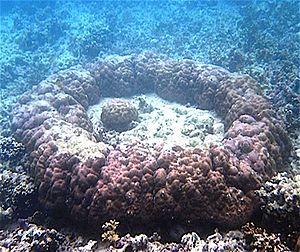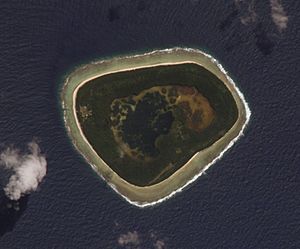Microatoll facts for kids
A microatoll is a special kind of circular coral group. It grows close to the ocean's surface. The very top of a microatoll often sticks out of the water. This means the corals there die because they can't stay wet. But the corals on the sides, which are always underwater, keep growing. This makes the microatoll grow outwards in a ring shape. Some microatolls can be quite large. They can grow up to 6 meters (about 20 feet) wide. That's like the length of a small school bus!
They are called "microatolls" because they look like much bigger island atolls. Famous scientist Charles Darwin first noticed this similarity in 1842.
Contents
What Microatolls Tell Us
Microatolls are more than just interesting coral shapes. Scientists use them to learn important things about our planet.
Tracking Sea Levels
Microatolls can help us understand how sea levels are changing. As the ocean rises or falls, the living part of the microatoll changes. This creates a record of past sea levels. By studying these records, scientists can see how much the sea has risen. This information is very helpful for understanding global warming and its effects.
Studying Earthquakes
These coral rings can also tell us about earthquakes. In areas where the Earth's crust moves a lot, the land can suddenly go up or down. Microatolls record these changes in sea level. Scientists can use them to figure out when and how much the land moved during past earthquakes. This helps us learn more about active fault lines.
Discovering Ocean Temperatures
Scientists can even use microatolls to find out about past ocean temperatures. The way corals grow is affected by the water temperature. By studying the growth patterns in microatolls, researchers can get clues about how warm the surface water was long ago. This helps us understand changes in ocean climate over time.



